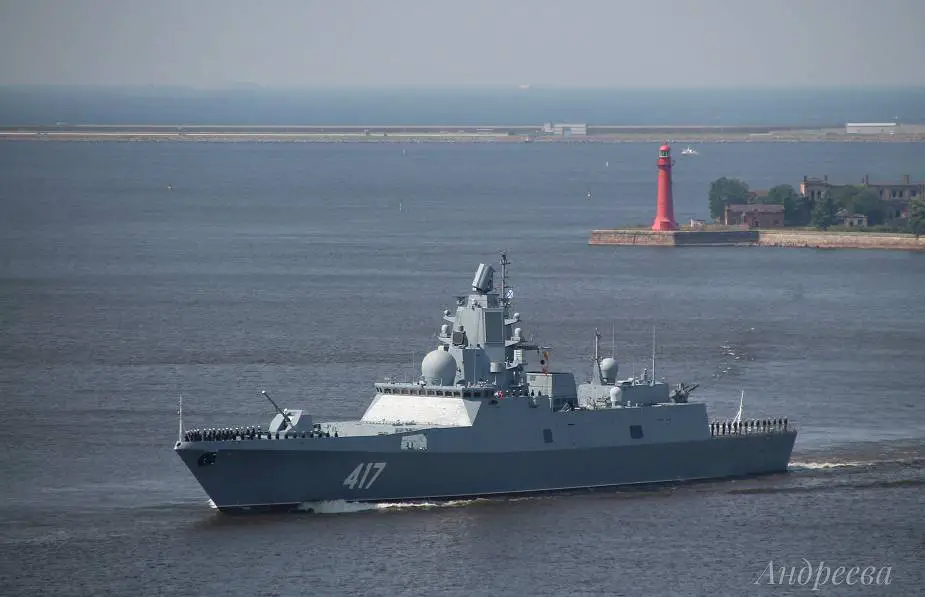According to information published by the Russian press agency TASS on November 6, 2020, Russian navy Project 22350 Admiral Gorshkov class frigates will be armed with the latest anti-submarine weapons. They will be the first to operate guided antisubmarine missiles which can hit targets at a distance of dozens of kilometers, the Izvestia daily writes.
Follow Navy Recognition on Google News at this link
 Russian Navy Project 22350 Admiral Sergei Gorshkov. (Picture source RussianDefence.net)
Russian Navy Project 22350 Admiral Sergei Gorshkov. (Picture source RussianDefence.net)
The Russian Navy command has determined which warships will get the latest antisubmarine weapons. The first will be projected 22350 frigates, Defense Ministry sources said. The new weapons are likely to be supplied in 2021.
Project 22350 also called Admiral Gorshkov-class is a guided missile frigate designed by the Severnoye Design Bureau and incorporates the use of stealth technology. As of August 2020, ten vessels have been contracted by the Russian Navy for delivery by 2027. The new frigates feature stealth capabilities and carry high-precision weapons. They are being built by Severnaya Verf (United Shipbuilding Corporation).
Project 22350 has a displacement capacity of 5,000 t, the 135 m-long and 16m-wide vessels can reach a top speed of 30 knots. The ships can accommodate around 200 people.
Project 22350 is armed with one 130 mm Amethyst/Arsenal A-192M naval gun, 16 (2 × 8) UKSK VLS cells for Kalibr, Oniks or Zircon anti-ship cruise missiles, 24 (3 × 8) UKSK VLS cells for Kalibr, Oniks or Zircon missiles (Admiral Amelko, Admiral Chichagov, Admiral Yumashev and Admiral Spiridonov), 32 (2 × 16) Redut VLS cells for 9M96, 9M96M, 9M96D/9M96DM(M2) and/or quad-packed 9M100 surface-to-air missiles, two Palash CIWS Close-in Weapon, eight 330 mm torpedo tubes for Paket-NK anti-torpedo/anti-submarine torpedoes and two 14.5 mm MTPU pedestal machine guns.
Guided antisubmarine missiles are the most dangerous weapon for submarines. Depth bombs do not have high precision, while torpedoes have a short-range. A missile can be fired to dozens of kilometers. In the assigned area, it releases a small torpedo which searches for an underwater object and destroys it.
It was reported in August 2019 that the design was in a high state of readiness. Deputy Defense Minister Alexey Krivoruchko later said development batch had been produced and its trials were to end in 2020. On October 18, the Northern fleet reported a successful launch of the antisubmarine missiles from the Admiral Kasatonov frigate in the Barents Sea. The test-fire was conducted in the framework of qualification trials and recognized as successful.
Lead experts of the Center of naval analysis Mikhail Kofman said there is nothing more lethal for a modern warship than a submarine. It can rapidly destroy a warship if it comes to a distance of torpedo fire. “Submarines remain the main threat for warships no matter how big, perfect and technological they are, as submarines carry cruise missiles,” he said.
Kofman said the missile is most effective when the warship operates together with antisubmarine aircraft. They release acoustic buoys to hear the underwater situation. When a buoy detects the submarine noise, the warship fires a torpedo at the coordinates.
Yet the Soviet Navy had such weapons, but there were no such detection systems as today, former Navy Chief-of-Staff Admiral Valentin Selivanov said. Warships received coordinates from aircraft or another warship. “Project 22350 frigates have a major detection range to effectively engage missile-torpedoes. If a submarine is detected at a distance of 100 km, the advantage should be used. The submarine has to approach to 20 km for torpedo attack, and you preempt it. If the acoustic units on project 22350 frigates and missilemen properly operate the weapon, the warship will always defeat a submarine,” he said.
Brown and blue-water warships will be armed with missile-torpedoes. A modification will be created for antisubmarine aircraft, expert Igor Kurdin said.
“Submarine commander believes surface warships are far away when he enters the distant antisubmarine defense zone. He does not feel the danger like he experiences at a distance of a torpedo attack. When you do not hear the noise of antisubmarine ships and all of a sudden a torpedo attacks you, there is no time to escape it,” he said.
The guided antisubmarine missile is carried in transportation-launch container. It has two modules — launch and combat control, as well as a power source and auxiliary systems.
The containers can be installed in the coastline, naval bases, warships and vessels, rail and road platforms. Preparation of the transportation-launch container takes little time, as contact with submarine often lasts only minutes and the weapon is easy to use.
The guided missile can be integrated into automatic controls of warships and aircraft-warship formations. It thus uses airplanes and helicopters as scouts that find submarines and provide guidance to the carriers of new weapons, the Izvestia said.
© Copyright 2020 TASS Navy Recognition. All rights reserved. This material may not be published, broadcast, rewritten or redistributed.



